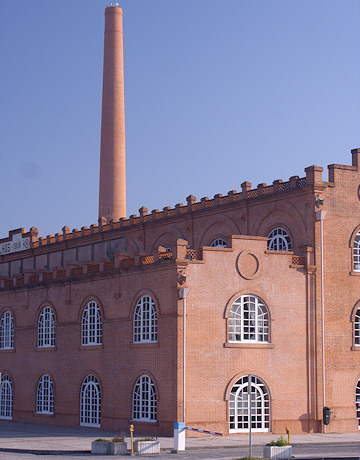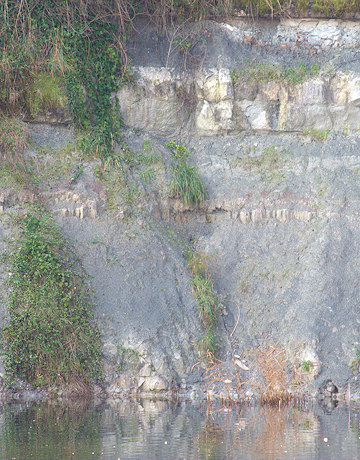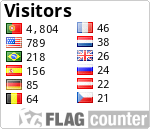
A
Earthcache
Apesar de, por questões de segurança, não ser possível aproximar-se mais do Barreiro pode ver-se os extractos dos sendimentos na parede do fundo. Não tente aproximar-se!
No texto abaixo, assim como no local das coordenadas, poderá obter as informações necessárias para responder às seguintes questões. Estas devem ser respondidas para o meu
email de modo a poder fazer o registo como encontrada. Se tal não for feito o registo será apagado sem qualquer tipo de aviso. Não necessita de esperar pela minha autorização para efectuar o registo. Se existir algum problema será contactado(a) de modo a resolvê-lo.
- Como era a paisagem e o clima da região de Aveiro durante o período Cretácico?
- Qual a altura da parede de fundo do Barreiro?
- Qual o diâmetro aproximado do Barreiro?

The Earthcache
Although, for security reasons, it is not possible to get closer to the Clay Pit one can see the exctracts of sendiments in the back wall. Don't try to get closer!
In the text below, as well in the place pointed by the coordinates, one can find the necessary information to answer the following questions. These should be sent to my email in order to make a found log. Failing to do this will result in the deletion of your log without notice. You don't need to wait for permission to log. If there is a problem you will be contacted to resolve it.
- How was the landscape and the climate of the Aveiro region during the Cretaceous period?
- How high is the wall in the back of the Clay Pit?
- What it is the approximate diameter of the pit?


Barreiro da Fábrica Campos
A
argila é uma rocha granular com grãos de dimensões muito reduzidas. Tem origem na desagregação de rochas feldspáticas, por ataque químico fragmentando-as em partículas muito pequenas. Normalmente as jazidas são formadas pelo processo de depósito aluvial ou seja, as partículas menores (e portanto mais leves), são levadas pela corrente de água e depositadas no lugar onde a força hidrodinâmica já não é suficiente para mantê-las em suspensão. Tipicamente grandes lagos ou depósitos marinhos.
Neste local existem argilas que não são mais do que sedimentos muito finos trazidos por via fluvial e acumulados numa área plana, próxima do mar, que caracterizou toda a região de Aveiro, no
Cretácico Superior, há cerca de 65 a 70 milhões de anos. Durante quase todo este período, houve também um avanço dos mares sobre as áreas terrestres, como pode ser testemunhado pelos achados encontrados no seio destas argilas tais como fósseis animais e vegetais. Estes fósseis permitem-nos reconstituir uma paisagem tropical, alagadiça, onde, entre outros, viveram dinossauros, crocodilos, tartarugas e peixes de grandes dimensões.

Em termos climáticos, o Cretácico era, no princípio, mais quente que os dias de hoje, enquanto as massas terrestres estavam ainda a afastar-se do equador. A extinção dos dinossauros e o declínio de outros répteis aconteceu no final do Cretácico, e ainda hoje continua sem explicação definida.
Toda a região de Aveiro é rica em argilas (os barros no vocábulo popular) que constituíram e constituem ainda uma fonte de riqueza para a economia regional, nomeadamente com a sua utilização na produção cerâmica. Os dados arqueológicos conhecidos permitem afirmar que já existia a utilização de cerâmicas pelo Homem que habitava esta região há cerca de 5000 anos.
O Barreiro da Jerónimo Pereira Campos, que durante décadas serviu como fonte da matéria prima para a fábrica, é o único e último testemunho na região do Cretácico, esse tempo antigo imediatamente anterior à grande extinção que marcou o fim da Era
Mesozóica e o começo dos tempos modernos, com grandes mudanças no clima, na flora e na fauna.


Campos Factory Clay Pit
Clay is composed primarily of fine-grained minerals. Clay minerals are typically formed over long periods of time by the gradual chemical weathering of rocks, usually silicate-bearing. Clay deposits may be formed in place as residual deposits in soil, but thick deposits usually are formed as the result of a secondary sedimentary deposition process after they have been eroded and transported from their original location of formation. Clay deposits are typically associated with very low energy depositional environments such as large lakes and marine deposits.
In this place can be found clay minerals that are just very thin sediments brought by river and accumulated in a flat area, near the sea, that characterized the Aveiro region during the Late
Cretaceous, about 65 to 70 million years ago. During almost all of this period the sea advanced through land areas as can be attested by the finds within these clay sediments such as animal and vegetable fossils. These fossils allow to recreate a tropical landscape, marshy, where, among others, lived dinosaurs, crocodiles, turtles and fishes of large dimensions.
In terms of climate, the Cretaceous was, in the beginning, warmer than today, while the landmasses were still moving away from the equator. The extinction of the dinosaurs and the declining of other reptiles happen in the end of the Cretaceous, and still has no clear explanation.


Clay is found throughout all the Aveiro region. It was and still is one of the most important sources of income for the regional economic system, particularly within the ceramic industry. The known archeologic descoveries allow to say that the people living in this region more than 5000 years ago already used ceramics.
The Jerónimo Pereira Campos Clay Pit, that for decades served as the source of raw material for the factory, is, in the region, the unique and last existing remains of the Cretaceous, the ancient time immediately before the great extinction that marked the end of the
Mesozoic Era and beginning of modern times, with great changes in the climate, flora and fauna.
